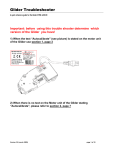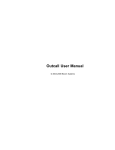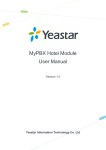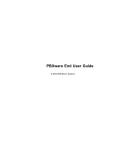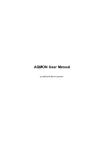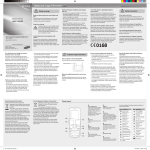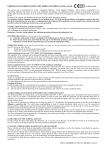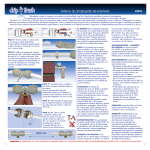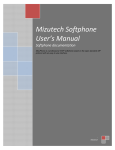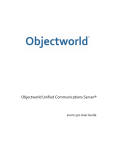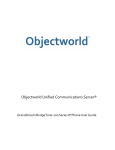Download AgentCOM User Manual
Transcript
AgentCOM User Manual AgentCOM User Manual Published July 2010 Copyright © 2003, 2004, 2005, 2006, 2007, 2008, 2009, 2010 Bicom Systems Table of Contents Overview ................................................................................................................................................vi 1. Configuration ...................................................................................................................................... 7 General .......................................................................................................................................... 7 Profile ............................................................................................................................................ 7 URL Popup .................................................................................................................................... 8 Other ............................................................................................................................................. 9 IDQ Portal .................................................................................................................................... 11 2. Features ........................................................................................................................................... 12 Active Call window ........................................................................................................................ 12 Queue information ........................................................................................................................ 14 Messages .................................................................................................................................... 14 Integrated Web browser ................................................................................................................ 15 3. Main menu ....................................................................................................................................... 17 File .............................................................................................................................................. 17 View ............................................................................................................................................ 17 Show tabs in separate Window .............................................................................................. 17 Show tabs in AgentCOM Window .......................................................................................... 18 Hide tabs ............................................................................................................................. 18 Skin ..................................................................................................................................... 18 Message History ................................................................................................................... 19 Network->Debug Info .................................................................................................................... 20 Help->About ................................................................................................................................. 21 iv List of Tables 1.1. General ........................................................................................................................................... 7 1.2. Profile .............................................................................................................................................. 8 1.3. URL Popup ...................................................................................................................................... 9 1.4. Other ............................................................................................................................................. 10 1.5. IDQ Portal ...................................................................................................................................... 11 2.1. Login window ................................................................................................................................. 12 2.2. Information about call ..................................................................................................................... 13 2.3. Control buttons .............................................................................................................................. 13 2.4. Queue information .......................................................................................................................... 14 3.1. Items in File menu .......................................................................................................................... 17 3.2. Message History ............................................................................................................................ 20 v Overview AgentCOM is a desktop application that works on any Windows operating system. The purpose of this application is to make day-to-day work easier for agents in Call Centers. It enables the agent to easily answer the call, reject it, transfer to another number, or interact with a CRM which can be shown to the agent. vi Chapter 1. Configuration When AgentCOM starts for the first time, the manager/administrator will have to set up the server, extension, and password to which AgentCOM will send calls. Clicking on File->Configuration menu will bring up configuration dialog which the manager can use to set AgentCOM preferences. Tip Password that is used for accessing the configuration is the current date in this form: DDMMYYYY General Table 1.1. General Field Description Make AgentCOM primary application Whether to set AgentCOM as always on top and not minimizable Bring AgentCOM to front on incoming call Should incoming calls bring AgentCOMs windows to the front Profile 7 Configuration Table 1.2. Profile Field Description Example Server: Enter the IP address or hostname of 10.1.0.124:5037 - This will tell PBxware to which to connect. AgentCOM to login to this IP using port 5037 Extension: Extension number (phone) which is going to be used to log agents to 1002 Extension's secret: Password that is used for that extension $#v2tr2232!"$efwe Dialer port: If the dialer will be used within AgentCOM, set its port here 10002 Tip Extension that is going to be used must have "In Manager Proxy" option turned ON in PBXware GUI URL Popup 8 Configuration One of the features that takes up most of the main AgentCOM screen is URL Popup, which can actually show a webpage depending on the settings that you set here. It can show the webpage of your favorite CRM to help the agent in his or her job, such as searching for details on the caller, etc. Table 1.3. URL Popup Field Description Example Show URL Popup tab Whether to show URL Popups at all Checkbox URL options: Use URL specified in AgentCOM or Use URL specified in AgentCOM URL specified in the "Queue URL" field in a queue in PBXware interface URL (%CALLERID% macro can be Which URL to show in a popup for used) every call Other 9 If using a CRM which can present information about the caller, you can use %CALLERID% macro to send the CallerID to the CRM so that it can present the according information to the agent Configuration Table 1.4. Other Field Description Enable Hangup Button Whether to enable the hang-up button for the agent to use Enable Reject Button Whether to enable the reject button for the agent to use Enable Transfer Button Whether to enable the transfer button for the agent to use Enable IVR Transfer Button Whether to enable the IVR transfer button, which, when pressed, asks the agent to enter a number. That number will be used as a context to which the caller will be sent to. Custom AGI script on the PBXware will then decide what to do with the call Write CurrentCall.xml file Whether to save the CurrentCall.xml file for the current call taken by an agent Tip CurrentCall.xml file is in the following form: <?xml version="1.0"?> <CurrentCall> <CallTime>30.07.2010 15:49:13</CallTime> <CallerNumber>104</CallerNumber> <CallerName>Kiax Test</CallerName> <Direction>Inbound</Direction> <Agent>1000</Agent> 10 Configuration <AgentName>Denis Test</AgentName> <QueueName>Denis</QueueName> <QueueNumber>106</QueueNumber> <UniqueID>1280497695.52</UniqueID></CurrentCall> IDQ Portal Set the parameters used for integration with the IDQ Portal phone database software. Table 1.5. IDQ Portal Field Description Enable IDQ Portal integration Whether to enable integration with the IDQ Portal phone database IDQ Portal application path: Path for the IDQ Portal application Use AgentCOM username and password for authorization Whether to use AgentCOM's username and password or set new ones here Username: Username for IDQ Portal authorization Password: Password for IDQ Portal authorization 11 Chapter 2. Features The first time you start the AgentCOM application, you will need to login either as a static agent or a dynamic one. Table 2.1. Login window Field Description Example Profile: Select a profile to use for login. The profile can be defined as a simple TXT file which has a name profileX.txt where X is a number. [back-office] server=192.168.0.12 username=6502 secret=4TRZBG65G Agent number: Agent number used for logging in 1000 PIN: PIN number of the agent, supplied above 7474 Agent type: Depending on what you select here, Static Agent you will be a callback agent which means that on every queue call, system will call your extension. If you chose Static Agent, your phone will be called and you will listen to music on hold until the call is put through. Active Call window 12 Features The Active Call window shows information about the caller and possible actions that the agent can take. The top of the active call window shows the Agent's name and number, whether it is a static or callback agent, and his availability. The circular red-white button that you see on the top right is used to send an assistance request to the supervisor(s) that are monitoring agents with AQMON. Table 2.2. Information about call Field Description 1005 (John Crichton) As seen in the example, this will show the full CallerID of the caller. NOT READY This is a button which agent can use to put himself in not ready state so his client wouldn't receive any calls during that time. When agent click on NOT READY button it will change label to a timer which will show the time that agent spent as not ready. When you click on it again, agent will start receiving calls again. Call Status: Status of the incoming call, whether it is ringing or answered. Duration: Duration of the call in question. Unique Call ID: This field shows the unique call ID as seen in PBXware for current call. Queue: This field shows the name and number of the queue from which the call came. Table 2.3. Control buttons Button Description Accept When AgentCOM is used in conjuction with PBXware dialer, and the dialer is using the "preview" strategy, this option is available. The dialer will send the next call that will be made and the agent will be able to approve 13 Features Button Description clicking on Accept or reject using the Reject button (ex Hang-up button) Hangup/Reject The Hang-up button, as its name suggests, is used to hang-up the call. The reject button is used to reject a call coming from Dialer. Transfer Transfer an incoming call to some other number IVR Transfer This button transfers the call to a given number/context which is already created on PBXware. On PBXware, there is an AGI script which will then proceed with the call as the customer programmed it to. Queue information The queue informaton tab shows basic information about queues of which the agent is a member. Table 2.4. Queue information Field Description Queue Name This row show queue names and numbers. Of course it will show only queues of which the agent is a member. Members/Logged In Shows the total number of members of the queue and the number of logged in members. Waiting Shows the number of calls in the queue which are waiting to be answered. Tip Campaigns tab shows the name and number of members inside a campaigns if AgentCOM is used in conjuction with PBXware dialer. Messages The messages section is used to show messages that supervisors send to agents. Also, you have the ability to send a message to your supervisor if you need to. The top of the section has arrows pointing left and right which are used to browse through the messages that the agent has received. 14 Features The middle of the section shows the type of the message and message contents. If you click on the Send message button, you will have the ability to choose which supervisor you want to send a message to, and then type the message you want to be sent. The supervisor will see the message and any response from him/her will be seen as a new message here. Integrated Web browser The Integrated Web browser is used to show any information that the agent requires or to show the information from a CRM which is usefull if you want to pull information about the current caller or anything else call-regarded. The integrated browser uses your system's Internet Explorer as the engine. 15 Features 16 Chapter 3. Main menu This chapter describes functionality of every single item from main menu. File Table 3.1. Items in File menu Item Description Log Out When you click here, the application will log out the agent using it. Configuration This will bring up the configuration dialog which is described in Configuration Exit Exits the application View Show tabs in separate Window This option will show the URL popup tabs in separate windows as per the screenshot. 17 Main menu Show tabs in AgentCOM Window This is the default option in AgentCOM where the URL popup tabs are shown in the same window as other parts of the application. Hide tabs This option will hide the URL popup tabs and show only the main part of the application. Skin AgentCOM has three skins that agents can use: • Skin 1 is the default skin that you see when you run the program. • Skin 2 changes the look of main part of the application. Active call and queue info show less information while messages are not seen (screenshot below) • Skin 3 hides AgentCOM altogether where the agent will only receive a popup from the tray bar when a call comes in. When the application is in Skin 2 mode, it looks like this: 18 Main menu When application is in Skin 3 mode, it will hide and show only an icon in the tray from which the user will get a popup which notifies him of incoming calls: Message History Message History lists all of the messages that the agent received from the supervisor(s). 19 Main menu Table 3.2. Message History Field Description From Which supervisor sent the message Message type Whether the message is an alert, warning, or info Date/Time Date/Time when the message was sent Message This row shows the first few words of the message that the agent received Message: Complete text of the selected message Network->Debug Info This menu will bring up a new window with two tabs containing debug output from the Manager and Dialer. 20 Main menu This window contains one menu which has three items. Those items will allow you to copy the contents of the window to the clipboard, clear the contents of the window, or close it altogether. Help->About This menu shows the about window. 21






















